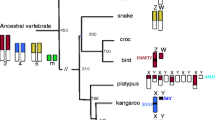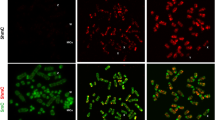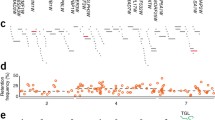Abstract
The male hypermethylated (MHM) region of the chicken Z chromosome encodes a non-coding RNA that is expressed only in females. The MHM sequence is found only in galliform birds, and Z genes near this region show an unusual degree of dosage compensation between males and females despite the overall low level of dosage compensation in Z chromosome gene expression in birds. Here we report that the MHM locus shows a dramatic sex difference in the configuration of chromatin, open in females and condensed in males, based on DNA fluorescent in situ hybridization of an MHM probe in interphase nuclei. The demethylating agent 5-aza-cytidine causes an asymmetric effect on the two Z chromosomes of males, altering the chromatin configuration, MHM RNA expression, and H4K16Ac modification, suggesting an inequality in the methylation status and chromatin of the two Z chromosomes. We identified numerous MHM-related genomic and RNA sequences that possess a short conserved sequence common to the majority of clones, suggesting the functional importance of the MHM region. Some of the RNA sequences, which like MHM are expressed in females but not in males, are likely to be polyadenylated and have genomic intron/exon structure. The turkey, another galliform bird, has repetitive sequences in the predicted turkey MHM region, raising the question of regional dosage compensation in the turkey as in the chicken.

















Similar content being viewed by others
References
Arnold AP, Itoh Y, Melamed E (2008) A bird's-eye view of sex chromosome dosage compensation. Annu Rev Genomics Hum Genet 9:109–127
Baverstock PR, Adams M, Polkinghorne RW, Gelder M (1982) A sexlinked enzyme in birds-Z-chromosome conservation but no dosage compensation. Nature 296:763–766
Bisoni L, Batlle-Morera L, Bird AP, Suzuki M, McQueen HA (2005) Female-specific hyperacetylation of histone H4 in the chicken Z chromosome. Chromosome Res 13(2):205–214
Ellegren H, Hultin-Rosenberg L, Brunström B, Dencker L, Kultima K, Scholz B (2007) Faced with inequality: chicken do not have a general dosage compensation of sex-linked genes. BMC Biol 5:40
Griffin DK, Robertson LB, Tempest HG, Vignal A, Fillon V, Crooijmans RP, Groenen MA, Deryusheva S, Gaginskaya E, Carré W, Waddington D, Talbot R, Völker M, Masabanda JS, Burt DW (2008) Whole genome comparative studies between chicken and turkey and their implications for avian genome evolution. BMC Genomics 9:168
Itoh Y, Arnold AP (2005) Chromosomal polymorphism and comparative painting analysis in the zebra finch. Chromosome Res 13:47–56
Itoh Y, Kampf K, Arnold AP (2006) Comparison of the chicken and zebra finch Z chromosomes shows evolutionary rearrangements. Chromosome Res 14(8):805–815
Itoh Y, Melamed E, Yang X, Kampf K, Wang S, Yehya N, Van Nas A, Replogle K, Band MR, Clayton DF, Schadt EE, Lusis AJ, Arnold AP (2007) Dosage compensation is less effective in birds than in mammals. J Biol 6(1):2
Itoh Y, Replogle K, Kim YH, Wade J, Clayton DF, Arnold AP (2010) Sex bias and dosage compensation in the zebra finch versus chicken genomes: general and specialized patterns among birds. Genome Res 20(4):512–518
Kuroda Y, Arai N, Arita M, Teranishi M, Hori T, Harata M, Mizuno S (2001) Absence of Z-chromosome inactivation for five genes in male chickens. Chromosome Res 9(6):457–468
Kuroiwa A, Yokomine T, Sasaki H, Tsudzuki M, Tanaka K, Namikawa T, Matsuda Y (2002) Biallelic expression of Z-linked genes in male chickens. Cytogenet Genome Res 99(1–4):310–314
Mank JE, Ellegren H (2009) All dosage compensation is local: gene-by-gene regulation of sex-biased expression on the chicken Z chromosome. Heredity 102(3):312–320
McQueen HA, McBride D, Miele G, Bird AP, Clinton M (2001) Dosage compensation in birds. Curr Biol 11(4):253–257
Melamed E, Arnold AP (2007) Regional differences in dosage compensation on the chicken Z chromosome. Genome Biol 8(9):R202
Melamed E, Elashoff D, Arnold AP (2009) Evaluating dosage compensation on the chicken Z chromosome: should effective dosage compensation eliminate sexual bias? Heredity 103(5):357–359
Naurin S, Hansson B, Bensch S, Hasselquist D (2010) Why does dosage compensation differ between XY and ZW taxa? Trends Genet 26(1):15–20
Naurin S, Hansson B, Hasselquist D, Kim YH, Bensch S (2011) The sex-biased brain: sexual dimorphism in gene expression in two species of songbirds. BMC Genomics 12(1):37
Teranishi M, Shimada Y, Hori T, Nakabayashi O, Kikuchi T, Macleod T, Pym R, Sheldon B, Solovei I, Macgregor H et al (2001) Transcripts of the MHM region on the chicken Z chromosome accumulate as non-coding RNA in the nucleus of female cells adjacent to the DMRT1 locus. Chromosome Res 9(2):147–165
Zha X, Xia Q, Duan J, Wang C, He N, Xiang Z (2009) Dosage analysis of Z chromosome genes using microarray in silkworm, Bombyx mori. Insect Biochem Mol Biol 39(5–6):315–321
Zhang SO, Mathur S, Hattem G, Tassy O, Pourguie O (2010) Sex-dimorphic gene expression and ineffective dosage compensation of Z-linked genes in gastrulating chicken embryos. BMC Genomics 11:13
Acknowledgements
This work was supported by NIH grant DC000217 to A.P. Arnold and a Yamada Science Foundation grant to Y. Itoh. We thank Dr. Mika Teranishi for sharing the DNA clones and Dr. Michael Grunstein for the gift of H4K16Ac antibody.
Author information
Authors and Affiliations
Corresponding author
Additional information
Communicated by L. Comai
Electronic supplementary material
Below is the link to the electronic supplementary material.
Fig. S1
Several examples of “open” and “closed” signals in FISH using MHM BAC DNA as a probe. A–C are male (ZZ) nuclei, and signals are “closed”. In females (D–F), there is a cluster of three or more spots, which we defined as “open” (JPEG 3622 kb)
Rights and permissions
About this article
Cite this article
Itoh, Y., Kampf, K. & Arnold, A.P. Possible differences in the two Z chromosomes in male chickens and evolution of MHM sequences in Galliformes. Chromosoma 120, 587–598 (2011). https://doi.org/10.1007/s00412-011-0333-x
Received:
Revised:
Accepted:
Published:
Issue Date:
DOI: https://doi.org/10.1007/s00412-011-0333-x




